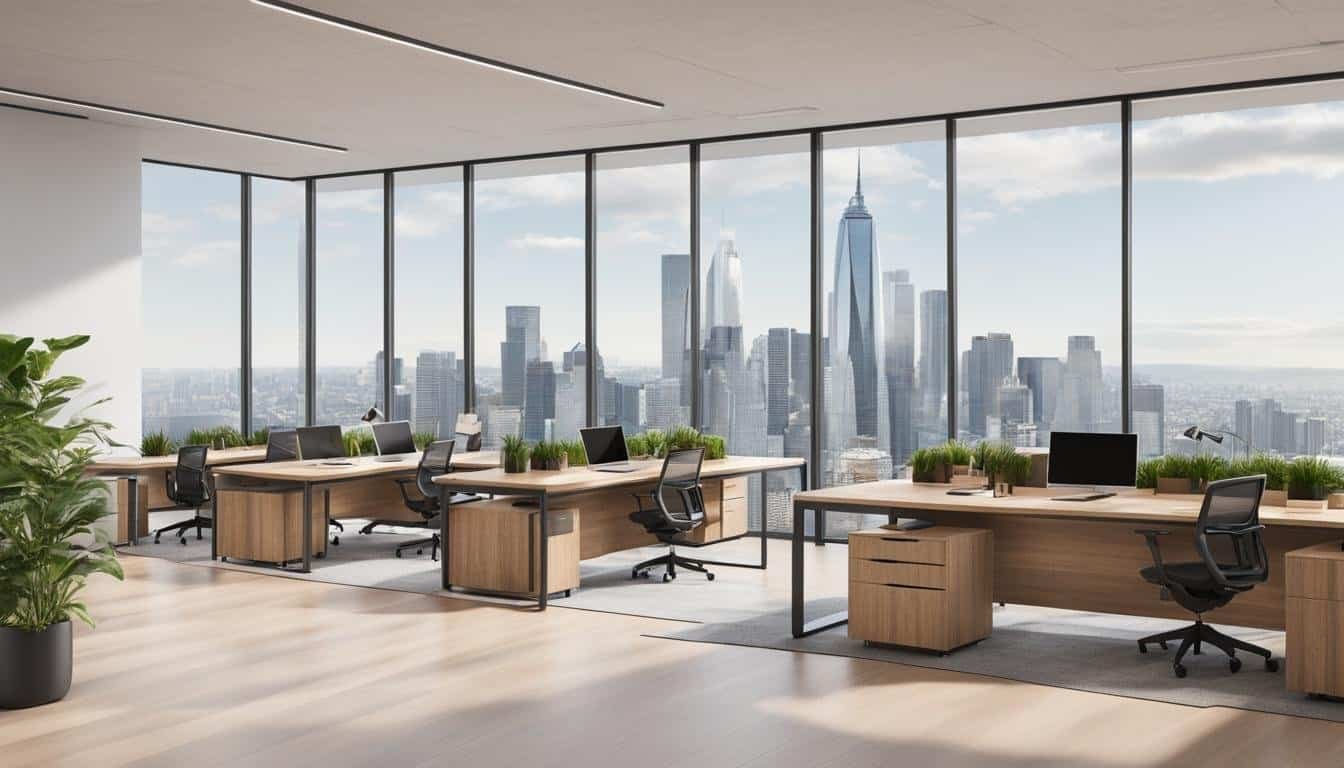The Evolution of Office Spaces in the Era of Hybrid Work
The office space is undergoing a significant transformation in the era of hybrid work. With the rise of remote and hybrid work, organizations are rethinking how they utilize their office spaces. According to JLL research, 53% of organizations will make remote working permanently available to all employees by 2025. This shift has led to an evolution in office space trends, such as open and collaborative spaces with no dedicated desk spaces. Commercial real estate (CRE) landlords have the opportunity to capitalize on these changes by providing data-driven solutions and creating buildings that meet the evolving needs of tenants.
Key Takeaways:
- The evolution of office spaces is driven by the rise of remote and hybrid work.
- Open and collaborative spaces with no dedicated desk spaces are the new trend.
- Commercial real estate landlords can capitalize on these changes.
- Data-driven solutions and buildings that meet the evolving needs of tenants are essential.
- 53% of organizations will make remote working permanently available to all employees by 2025.
The Rise of Hybrid Work and Remote Work Trends
Hybrid work and remote work have become prevalent trends in the modern workplace environment. With the Covid-19 pandemic, many organizations have adopted flexible work arrangements that allow employees to work from home or split their time between the office and remote locations. Research from JLL shows that 77% of organizational leaders believe offering remote or hybrid work is critical to attracting and retaining talent. As a result, the number of employers not offering any form of hybrid working option has dropped from 45% pre-pandemic to only 9% today. This shift in work dynamics has implications for office space design and utilization.
The Benefits of Hybrid Work and Remote Work
Hybrid work and remote work offer numerous benefits to both employees and employers. By allowing employees to work from home or choose flexible work arrangements, organizations can achieve a better work-life balance and improve employee satisfaction. Remote work eliminates commuting time and provides employees with more freedom and control over their work environment, ultimately enhancing productivity and well-being. Additionally, hybrid work models enable organizations to tap into a larger talent pool and attract diverse talent from different locations.
Challenges and Considerations for Office Spaces
The rise of hybrid work and remote work trends presents new challenges and considerations for office spaces. With fewer employees present in the office on a daily basis, companies need to reevaluate their office space utilization and design. Traditional cubicles and assigned desks may become less necessary as organizations prioritize collaboration and adaptability. Flexible work arrangements require office spaces that support team collaboration, innovation, and meetings, rather than simply providing individual workstations.
Furthermore, organizations must establish policies and implement technologies that enable seamless communication and collaboration regardless of employees’ physical locations. This may involve investing in video conferencing tools, project management platforms, and other remote work technologies. Providing a well-equipped and technologically advanced office environment can help to bridge the gap between in-person and remote collaboration, ensuring that employees can effectively work together regardless of their physical location.
Office Space Design Trends for Hybrid Work and Remote Work
Office space design is evolving to accommodate hybrid work and remote work trends. The focus is on creating flexible, adaptable, and inclusive work environments that cater to employees’ diverse needs. Collaborative spaces, such as open-plan layouts, coworking areas, and huddle rooms, encourage teamwork and idea-sharing. These spaces allow employees to collaborate and exchange ideas in a more relaxed and informal setting.
Moreover, organizations are incorporating technology-driven solutions into their office spaces to facilitate hybrid work. This includes providing a reliable and secure network infrastructure, implementing cloud-based storage and collaboration tools, and equipping meeting rooms with video conferencing capabilities. By integrating technology into office spaces, companies can ensure that employees have the necessary resources and connectivity to work effectively, whether they are in the office or working remotely.
| Office Space Design Considerations for Hybrid Work and Remote Work | Benefits |
|---|---|
| Open-plan layouts | Encourage collaboration and knowledge sharing |
| Flexible workstations | Allow employees to choose their preferred work environment |
| Technology integration | Facilitate seamless communication and remote collaboration |
| Dedicated collaboration spaces | Promote teamwork and idea generation |
| Wellness amenities | Prioritize employee well-being and work-life balance |
The evolving hybrid work and remote work trends are reshaping office spaces and transforming the traditional workplace. As organizations embrace these new ways of working, office spaces must adapt to support collaboration, flexibility, and employee well-being. The future of office design lies in creating dynamic, technology-enabled environments that foster innovation, engagement, and work-life balance.
Office Design Trends and Collaboration in the Modern Workplace
The evolution of office spaces has brought about a shift in design trends that prioritize collaboration and teamwork. Traditional cubicles and closed-off office spaces are being replaced by open and collaborative environments that foster innovation and communication.
According to JLL’s Future of Work Survey, an overwhelming 73% of organizations have either planned or are planning to make all office spaces open and collaborative, with no dedicated desk spaces. This significant shift towards flexible office layouts empowers employees to choose their workspaces based on their needs, promoting collaboration and flexibility.
The benefits of collaborative workspaces are clear. They promote a sense of community and shared purpose, allowing for greater exchange of ideas and knowledge among team members. The open office design encourages interaction and communication, breaking down barriers and facilitating seamless teamwork.
Benefits of Collaborative Workspaces:
- Enhanced teamwork and communication
- Increased cross-functional collaboration
- Improved creativity and innovation
- Flexibility in workspace utilization
- Boosted employee engagement and morale
By embracing collaborative workspaces, organizations create an environment that nurtures and supports effective team collaboration. Whether it’s through shared workstations, breakout areas, or agile workspaces that can be easily reconfigured, the focus is on fostering an atmosphere conducive to collaboration and creativity.
As the modern workplace continues to evolve, the integration of collaborative workspaces and open office designs has become vital for organizations seeking to optimize productivity and tap into the collective intelligence of their teams.
Technology in Office Spaces and Workplace Transformation
Technology plays a crucial role in transforming office spaces and enhancing workplace productivity. In today’s digital era, organizations are investing in various technological solutions to create a seamless and connected work environment that caters to the needs of employees.
One of the key aspects of technology integration in office spaces is the implementation of smart office solutions. These solutions leverage advancements in Internet of Things (IoT) technology to automate and optimize various aspects of the workplace, such as lighting, temperature control, and security. By integrating smart devices and sensors, organizations can create more efficient and sustainable office spaces, reducing energy consumption and improving overall workplace experience.
Digital programming is another area where technology is making a significant impact. Companies are leveraging digital platforms and software to provide employees with valuable resources and tools that enhance their productivity and well-being. For example, building apps are being used by property teams to offer online fitness classes, wellness tips, and other resources that support the physical and mental well-being of employees.
The integration of technology not only improves workplace productivity but also enhances the overall employee experience. With the advancement of digital tools and platforms, office spaces are becoming more adaptable and responsive to the changing needs of employees. Whether it’s through cloud-based collaboration tools, virtual meeting platforms, or mobile applications, technology is playing a vital role in enabling employees to work efficiently and effectively.
“The integration of technology not only improves workplace productivity but also enhances the overall employee experience.”
Moreover, technology is revolutionizing how office spaces are utilized. With the help of data analytics and workplace management software, organizations can gain valuable insights into space utilization patterns, allowing them to optimize and maximize the use of office spaces. This not only helps in reducing costs but also ensures that workspaces are aligned with the needs and preferences of employees.
The role of technology in office spaces and workplace transformation cannot be overstated. From smart office solutions to digital programming, organizations are leveraging technological advancements to create more productive, connected, and employee-centric work environments. By embracing these advancements, organizations can cultivate a culture of innovation, collaboration, and efficiency that drives business success.
The Impact of Hybrid Work on Office Space Demand
The rise of hybrid work has had a significant impact on office space demand. McKinsey predicts that by 2030, the demand for office space will be as much as 20% lower than it was in 2019. The flexibility and remote work options provided by hybrid work arrangements have led to organizations reevaluating their office space needs. This trend has driven a shift towards optimizing space utilization and adopting more agile workspaces. Companies are focusing on creating environments that align with new work habits and promote productivity, collaboration, and employee well-being.
As more employees embrace the flexibility of remote work, the demand for traditional office spaces has decreased. Organizations are now looking to optimize their existing office spaces and make them more adaptable to changing work dynamics. This includes rethinking the layout and design of work areas to accommodate both in-person and remote collaboration. By creating more agile workspaces, businesses can maximize the use of their office space and create an environment that supports the needs of their hybrid workforce.
One approach to space optimization is the implementation of hot desking or hoteling, where employees do not have assigned desks but can choose from a pool of available workstations. This not only reduces the amount of space dedicated to individual desks but also encourages collaboration and flexibility among employees. Additionally, companies are adopting technology solutions that allow for better workplace utilization tracking, enabling them to identify underutilized areas and make informed decisions regarding space allocation.
Furthermore, the impact of hybrid work on office space demand extends to the commercial real estate market as well. Landlords and property owners are facing the challenge of repositioning their properties to meet the changing needs of tenants. This includes redesigning office spaces to offer more flexibility, improving amenities, and embracing technology that enhances the overall workplace experience. By adapting to the demands of hybrid work, commercial real estate companies can attract and retain high-quality tenants in an increasingly competitive market.
In conclusion, the rise of hybrid work has significantly impacted office space demand. Companies are reevaluating their office space needs and focusing on optimizing space utilization to create agile workspaces that promote productivity, collaboration, and employee well-being. The commercial real estate industry must adapt to these changes by providing flexible, technology-driven solutions that meet the evolving needs of tenants. By embracing the shift towards hybrid work and space optimization, businesses can position themselves for success in the evolving workplace landscape.
The Changing Landscape of Office Locations and Retail Demand
The evolution of office spaces has not only impacted the design and utilization of workplaces but has also had a significant influence on office locations and neighborhood trends. As the Covid-19 pandemic reshaped work dynamics, people began reconsidering where they live and work, leading to shifts in office locations and real estate trends.
Research conducted by McKinsey revealed that individuals have moved away from expensive areas that were heavily concentrated with offices and have gravitated towards neighborhoods that offer a more diverse mix of real estate options. This trend has resulted in the emergence of mixed-use spaces, where offices, residential areas, and retail establishments coexist to create vibrant and innovative environments.
With the rise of remote and hybrid work, the demand for office spaces in traditional office districts has decreased. Remote and hybrid workers are spending less time near the office, causing a significant impact on retail demand in those areas. Retailers are now reevaluating their business models and strategies, focusing on creating mixed-use environments that cater to the needs and preferences of the evolving workforce.
“The Covid-19 pandemic has prompted a shift in people’s work and lifestyle choices. As a result, office locations have evolved, leading to the emergence of mixed-use spaces where people can live, work, and enjoy a variety of amenities in one neighborhood.” – McKinsey
This changing landscape presents both challenges and opportunities for real estate developers and businesses. Understanding the impact of remote work and office location trends allows organizations to adapt their strategies and offerings to meet the evolving demands of tenants and consumers.
Implications of Changing Workplace Dynamics on Retail Demand
| Key Factors | Implications |
|---|---|
| Decreased office space demand in traditional office districts | Shift in retail demand away from office-centric areas |
| Emergence of mixed-use spaces | Opportunity for retailers to cater to the diverse needs of residents and remote workers |
| Focus on creating vibrant and innovative environments | Enhanced customer experience and increased foot traffic |
The History of Office Design and its Evolution
Office design has come a long way, transforming from traditional private offices and cubicles to open and collaborative workspaces. The concept of creating an open environment for sharing information and promoting collaboration dates back to the early 20th century. In the 1950s to 1980s, office design revolved around factory-like settings with rows of desks and private offices. However, workplace trends started to shift during the 1990s with the introduction of mobile technologies enabling remote work and flexible work habits.
The 1990s brought about the concept of open offices, lounges, and co-working spaces, where individuals could work in shared spaces rather than being confined to their own private offices. This open office concept was seen as a way to encourage collaboration and foster a sense of community among employees. The idea was that an open environment would facilitate communication, idea sharing, and teamwork.
However, as the open office concept gained popularity, it also faced criticism. Many employees found it challenging to focus and concentrate in a space with constant noise and distractions. The lack of privacy and personal space became a concern, leading to the development of solutions such as phone booths and designated quiet zones within open office settings.
The Covid-19 pandemic has further influenced the evolution of office design, with a focus on safety, productivity, and adaptability. Health and wellness considerations have become paramount, leading to changes in office layouts to incorporate social distancing measures. The pandemic has also accelerated the adoption of remote work, prompting organizations to reevaluate their physical office spaces and prioritize flexibility.
Overall, the history of office design showcases a transition from closed and isolated workspaces to open and collaborative environments. The evolving workplace trends and advancements in technology have driven this transformation, with the goal of creating spaces that facilitate communication, engagement, and productivity.
| Period | Office Design | Trends |
|---|---|---|
| Early 20th century | Private offices and cubicles | Focus on individual work |
| 1950s – 1980s | Factory-like settings with rows of desks and private offices | Separate workstations, limited collaboration |
| 1990s | Open offices, lounges, and co-working spaces | Emphasis on collaboration and community |
| Present | Flexible workspaces, social distancing measures | Adaptable and safe environments |
Post-COVID Office Design Trends and Adaptation
The Covid-19 pandemic has had a profound impact on office design, giving rise to new trends and considerations. In the post-COVID era, office spaces have undergone a transformation to prioritize cleanliness, safety, and adaptability. Companies are reimagining their office layouts to facilitate social distancing and implementing hands-free technology to minimize contact points. Outdoor meeting areas are being incorporated to provide employees with well-ventilated spaces for collaboration and discussions.
This evolution in office design aims to create environments that promote both productivity and collaboration. By implementing adaptable layouts and flexible workstations, companies can cater to the varying needs of their employees. This includes providing areas for both focused individual work and collaborative group projects.
One of the key focuses of post-COVID office design is office safety. Enhanced cleaning protocols, air filtration systems, and touchless entry systems are becoming standard features in modern offices. By prioritizing safety measures, companies can create a secure environment that instills confidence in employees returning to the office.
To maximize adaptability, companies are creating spaces that can easily be reconfigured as needs change. Modular furniture and movable partitions allow for a flexible office layout that can accommodate evolving work requirements. This also enables companies to optimize space utilization and cater to different workstyles and preferences.
In addition to safety and adaptability, the post-COVID office design aims to create environments that embrace wellness principles and practices. Incorporating elements such as natural lighting, biophilic design, and wellness rooms provide employees with spaces that promote mental and physical well-being. It is essential for companies to prioritize employee wellness to foster a positive and productive work environment.
“The post-COVID office design combines safety, adaptability, and wellness to create a workspace that meets the evolving needs of employees. By prioritizing these factors, companies can enhance productivity, collaboration, and overall employee satisfaction.”
The post-COVID office design trends reflect the changing demands of the modern workforce. By implementing these trends, companies can create office spaces that are not only functional but also conducive to employee well-being and success. Prioritizing cleanliness, safety, adaptability, and collaboration will contribute to a thriving work environment in the era of hybrid work.
Conclusion
The evolution of office spaces in the hybrid work era has brought about significant changes in the modern workplace. With the rise of remote work trends and advancements in technology, organizations have reimagined their office spaces to create collaborative and flexible environments that prioritize employee well-being and productivity.
This office space evolution has had implications for office design, space utilization, and the overall employee experience. Traditional cubicles and closed-off offices are now being replaced with open and collaborative workspaces that promote interaction and communication. Flexible office layouts with no dedicated desk spaces allow employees to choose their workspaces based on their needs, fostering collaboration and adaptability.
As the hybrid work era continues to shape the future of office spaces, it is crucial for businesses to adapt and embrace the evolving trends. By incorporating data-driven solutions, smart office technology, and innovative designs, organizations can attract and retain top talent in this new work landscape. The seamless integration of technology not only enhances workplace productivity but also allows for more efficient office space utilization.
In conclusion, the office space evolution in the hybrid work era reflects the changing dynamics of the modern workplace. Creating collaborative and flexible work environments that prioritize employee well-being and productivity is essential for organizations to thrive in this new era. By embracing these changes, businesses can stay ahead of the curve and cultivate a productive and engaging work environment for their employees.







